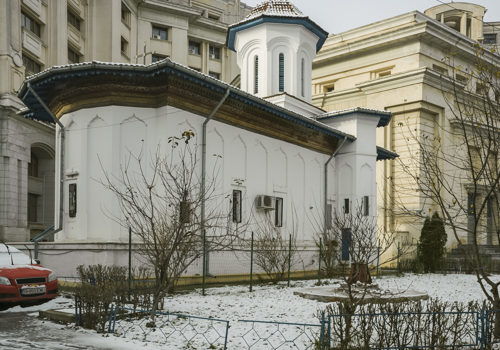Bucharest in the 1980s. Ceausescu’s “systematisation” programme is in full swing in the Romanian capital: one-third of the historic centre has been wiped out to make way for imposing buildings and wide avenues intended to honour the regime. Despite Ceausescu’s particularly dogged approach towards the churches, seven are spared and undergo a process as incredible as it is absurd: they are lifted and placed on rails then moved and hidden behind housing blocks. Withdrawn from the cityscape, they live secret lives in the disparate architecture that shapes Bucharest’s urban landscape today. By linking recent shots with archive material, in Mobile Churches the Romanian photographer Anton Roland Laub reveals a fascinating but less well-known chapter of recent European history.
Started in 2013 and produced over several years, this series has Laub’s personal experience as its source, when he witnessed as a child the complete metamorphosis of Bucharest, his native city, under the Ceausescu dictatorship. The latter razed to the ground a third of the historic city centre at the beginning of the 1980s in order to replace it with a gigantic palace and immense rectilinear avenues. Laub recalls that, on coming home from school, his mother made him make detours to see where there had been demolitions. It’s a story that has, of course, left its mark on him. In 2000 Laub moved to Germany to study photography. But Ceausescu regime’s stigmata remained one of his primary preoccupations.
Under this policy called “systemisation”, several thousand buildings were destroyed, among them about twenty churches. Surprisingly, seven churches were spared, doubtless because of pressure from the priests and their parishioners, and because an engineer by the name of Eugeniu Iordăchescu had come up with a technical solution consisting of lifting them up on jacks and moving them on rails. Relocated, they were then concealed behind curtains of Stalinist-style buildings. Even though they had escaped destruction, from a town-planning point of view this relocation constituted a veritable heresy, relocating a monument does not necessarily mean saving it when there is a distortion of the building’s connection with its environment.
The photographs of the seven churches came out of a process of identification and location that wasn’t always easy: there is no official inventory, the systemisation and its effects are not the subject of structured archives. Obviously the streets are no longer the same since whole neighbourhoods were razed and sometimes the churches themselves have changed their names. Once the research was finished, Laub had to make the churches visible again. Today these are situated in narrow backyards, are surrounded by cars, and often difficult to photograph in their entirety due to the lack of an available viewpoint. For some of his shots, Anton produced two images that he later joined together digitally. For others, he just chose to highlight the aberrant juxtaposition of the churches with their new neighbourhoods. This story brings with it a tragic dimension – we are talking about the greatest European peacetime destruction that required extravagant means while the population was dying of hunger – but also the total absurdity of it, all the more striking when we know that one of the churches was only moved a distance of fourteen metres or that the Romanian secret service ended up towering another…
Mobile Churches is being presented as both an exhibition and a book in a trilingual edition from Kehrer Verlag. In both cases, the idea was to connect Anton Roland Laub’s photographs, showing the current situation of the churches and the facades that hide them, and the historical documents: images from the archives and technical diagrams detailing the relocation process. To the seven chapters, one for each church, has been added an eighth section about the Great Synagogue of Bucharest, which was not relocated but was enclosed by the arms of a U-shaped building – a way of showing that other religious communities had also been affected.
As part of the Photo Saint-Germain, these images are being hosted by the church of Saint-Germain-des-Prés. Showing the photographs in such a place, weighed down with history and symbolism, is a real challenge. With the staging designer Cyril Delhomme, it was decided to produce prints on backlit plexiglass, which evokes stained glass and makes these orthodox churches come alive, a little like the icons within them.
Sonia Voss
Sonia Voss is an author and exhibition curator. She lives and works between Paris and Berlin.
Anton Roland Laub, Mobile Churches
From 3rd to 19th November 2017
Part of the Photo Saint-Germain Festival
Église Saint-Germain-des-Prés
3 Place Saint-Germain des Prés
75006 Paris
France
http://www.photosaintgermain.com/parcours/eglise-saint-germain-des-pres
Book published by Kehrer Verlag, 29€
https://www.kehrerverlag.com/en/anton-roland-laub-mobile-churches?___from_store=de
















